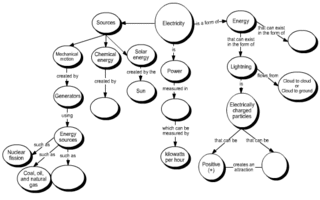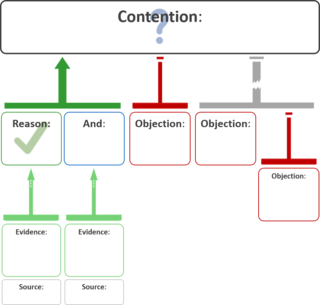
A mind map is a diagram used to visually organize information into a hierarchy, showing relationships among pieces of the whole. It is often created around a single concept, drawn as an image in the center of a blank page, to which associated representations of ideas such as images, words and parts of words are added. Major ideas are connected directly to the central concept, and other ideas branch out from those major ideas.
A graphic organizer, also known as a knowledge map, concept map, story map, cognitive organizer, advance organizer, or concept diagram, is a pedagogical tool that uses visual symbols to express knowledge and concepts through relationships between them. The main purpose of a graphic organizer is to provide a visual aid to facilitate learning and instruction.

Brainstorming is a creativity technique in which a group of people interact to suggest ideas spontaneously in response to a prompt. Stress is typically placed on the volume and variety of ideas, including ideas that may seem outlandish or "off-the-wall". Ideas are noted down during the activity, but not assessed or critiqued until later. The absence of criticism and assessment is intended to avoid inhibiting participants in their idea production.
Ideation is the creative process of generating, developing, and communicating new ideas, where an idea is understood as a basic element of thought that can be either visual, concrete, or abstract. Ideation comprises all stages of a thought cycle, from innovation, to development, to actualization. Ideation can be conducted by individuals, organizations, or crowds. As such, it is an essential part of the design process, both in education and practice.

A concept map or conceptual diagram is a diagram that depicts suggested relationships between concepts. Concept maps may be used by instructional designers, engineers, technical writers, and others to organize and structure knowledge.

Group concept mapping is a structured methodology for organizing the ideas of a group on any topic of interest and representing those ideas visually in a series of interrelated maps. It is a type of integrative mixed method, combining qualitative and quantitative approaches to data collection and analysis. Group concept mapping allows for a collaborative group process with groups of any size, including a broad and diverse array of participants. Since its development in the late 1980s by William M.K. Trochim at Cornell University, it has been applied to various fields and contexts, including community and public health, social work, health care, human services, and biomedical research and evaluation.

An argument map or argument diagram is a visual representation of the structure of an argument. An argument map typically includes all the key components of the argument, traditionally called the conclusion and the premises, also called contention and reasons. Argument maps can also show co-premises, objections, counterarguments, rebuttals, and lemmas. There are different styles of argument map but they are often functionally equivalent and represent an argument's individual claims and the relationships between them.
The seven management and planning tools have their roots in operations research work done after World War II and the Japanese total quality control (TQC) research.
Eight Disciplines Methodology (8D) is a method or model developed at Ford Motor Company used to approach and to resolve problems, typically employed by quality engineers or other professionals. Focused on product and process improvement, its purpose is to identify, correct, and eliminate recurring problems. It establishes a permanent corrective action based on statistical analysis of the problem and on the origin of the problem by determining the root causes. Although it originally comprised eight stages, or 'disciplines', it was later augmented by an initial planning stage. 8D follows the logic of the PDCA cycle. The disciplines are:

MindManager is a commercial mind mapping software application developed by Mindjet. The software provides ways for users to visualize information in mind maps and flowcharts. MindManager can be used to manage projects, organize information, and for brainstorming.

The affinity diagram is a business tool used to organize ideas and data. It is one of the Seven Management and Planning Tools. People have been grouping data into groups based on natural relationships for thousands of years; however, the term affinity diagram was devised by Jiro Kawakita in the 1960s and is sometimes referred to as the KJ Method.

Xmind is a mind mapping and brainstorming software, It is developed by XMIND LTD, a company registered in Hong Kong, and first released in 2007. The application can be used to visualize ideas, clarify thoughts, manage complex information, and promote team collaboration. People use Xmind to improve their productivity and creativity while working or learning. As of April 2013, Xmind was selected as the most popular mind mapping software on Lifehacker.There is also a branch in China Mainland called "深圳市爱思软件技术有限公司", although its role in XMind cannot be confirmed.
MindMapper is a mind mapping software and mental organization tool developed by SimTech Systems. It allows users to create a mind map from thoughts in the brain and convert it into software programs such as Word, PowerPoint, or Hangul Office. As of 2020, the software was used by more than 10,000 organizations and companies in 96 countries.

Mindomo is a versatile freemium collaborative mind mapping, concept mapping and outlining tool developed by Expert Software Applications. It can be used to develop ideas and interactively brainstorm, with features including sharing, collaboration, task management, presentation and interactive web publication.
Prewriting is the first stage of the writing process, typically followed by drafting, revision, editing and publishing. Prewriting can consist of a combination of outlining, diagramming, storyboarding, and clustering.
Idea networking is a qualitative method of doing a cluster analysis of any collection of statements, developed by Mike Metcalfe at the University of South Australia. Networking lists of statements acts to reduce them into a handful of clusters or categories. The statements might be source from interviews, text, websites, focus groups, SWOT analysis or community consultation. Idea networking is inductive as it does not assume any prior classification system to cluster the statements. Rather keywords or issues in the statements are individually linked (paired). These links can then be entered into network software to be displayed as a network with clusters. When named, these clusters provide emergent categories, meta themes, frames or concepts which represent, structure or sense-make the collection of statements.
ConceptDraw OFFICE is a proprietary office software suite of business productivity tools, developed by Computer Systems Odessa for use with either Microsoft Windows and macOS operating systems. ConceptDraw OFFICE is composed of mind mapping, project management and business diagramming tools. The three components use the cross-format exchange technology, allowing users to employ a visual approach to information management whereby the same set of data can be shown as a mind map, Gantt chart, or business graphic design.
ConceptDraw MINDMAP is proprietary mind mapping and brainstorming software developed by CS Odessa for Microsoft Windows and Apple macOS operating systems.
In computer supported brainstorming, team members contribute their ideas through electronic means either synchronously or asynchronously. The brainstorming software selected by the team mediates the individual interactions and helps to organize and shape the products of the brainstorming session. Computer supported brainstorming can be implemented using a wide variety of electronic technologies.








